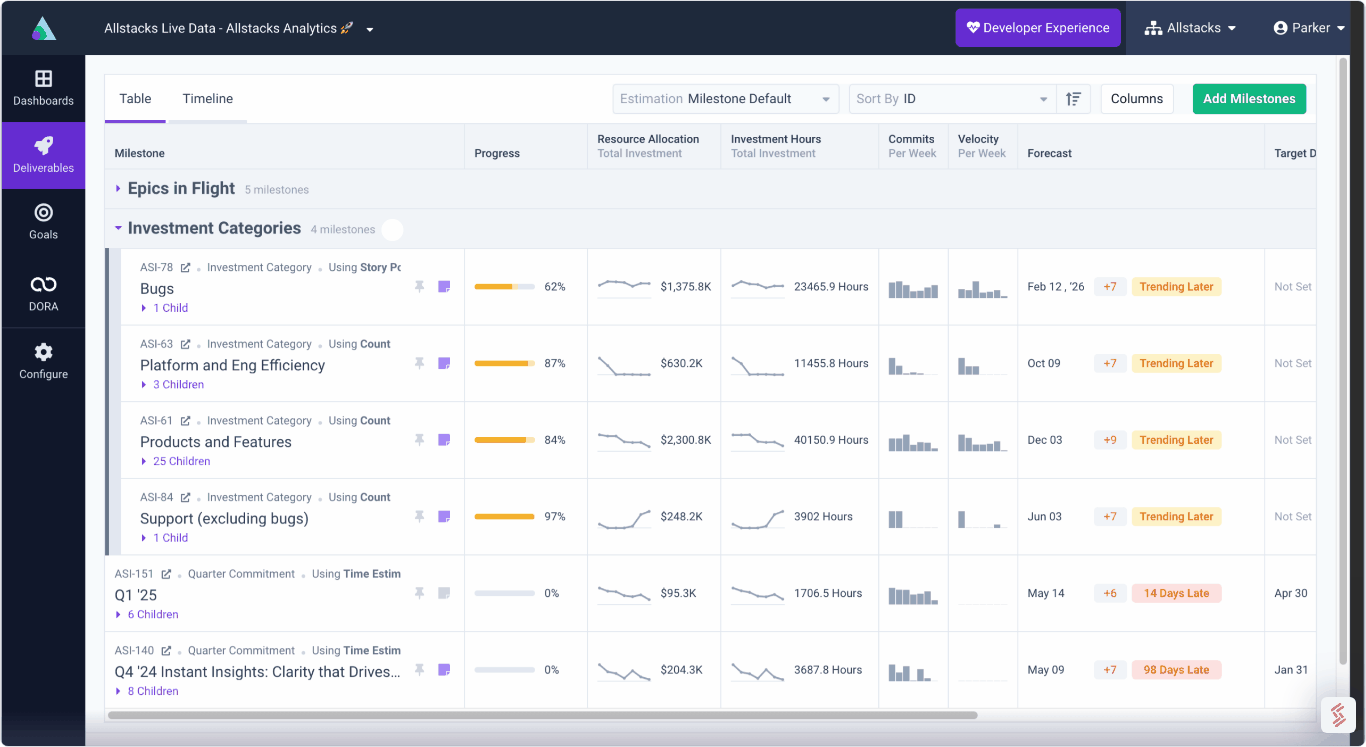.png)
Software Engineering Intelligence
-
Intelligence Engine
On-demand exhaustive AI-analysis
-
Engineering Investment
Complete visibility into time & dollars spent
-
360º Insights
Create meaningful reports and dashboards
-
Project Forecasting
Track and forecast all deliverables
DevEx
-
Developer Surveys
Create and share developer surveys
Software Capitalization
-
R&D Capitalization Reporting
Align and track development costs
Welcome to the Run Phase: Mastering Software Engineering Metrics
In this third installment, we're tackling the "Run Phase" – where your metrics program transforms from a useful tool into a strategic superpower.

In this third installment, we're tackling the "Run Phase" – where your metrics program transforms from a useful tool into a strategic superpower. Think of this as your graduation from metrics student to metrics master. The Run Phase isn't just about doing metrics better; it's about fundamentally changing how your organization makes decisions, allocates resources, and delivers value. Ready to leave the walking path behind and hit the open road at full speed? Let's dive into what true metrics mastery looks like!
From Walking to Running: The Next Evolution
You've established baseline metrics and built predictability in your development process. Now it's time to transform metrics from tracking tools into strategic drivers that power decision-making and continuous improvement across your organization.
- Connect Allstacks dashboards to executive reporting processes to highlight business impact
- Establish quarterly metrics progress reviews to ensure measurements remain relevant
- Develop team-specific metric goals tied to organizational objectives
- Ensure every person in the organization can connect the work they are doing to the greater organizational goal it is tied to
Figure 1 - Executive Reporting
Note: The above is an example of an executive summary/readout combining featuring several metrics highlighting both speed and quality over a 6 month period. This advanced analysis enables longer horizon modeling and organizational strategy relative to engineering improvement focus areas. Additionally, this shows a long term commitment to understanding SW Development behaviors and whether targeted improvements are taking hold.
From Reactive to Predictive Analytics
Predictive capabilities represent the hallmark of a mature metrics program. By leveraging historical data patterns, you can anticipate challenges before they materialize and position resources proactively rather than reactively.
- Develop leadership facing dashboards that speak business language, not tech jargon
- Use Allstacks' analytics to predict which projects may need intervention with Allstacks Investment Intelligence
- Implement forecasting models based on your historical
agility and quality data
Figure 2: Allstacks Investment Intelligence View
Note: In this view, the actual investment by portfolio project is demonstrated through Allstacks Investment Algorithm. This enables a clear view depicting if the highest priority projects are getting the investment expected. In this example, it is clear there are 3 projects getting the most attention - but are they the most important efforts?
Building a True Metrics Culture
A metrics-driven culture represents the ultimate achievement of the Run phase. When metrics thinking becomes instinctive rather than forced, your organization has truly reached metrics maturity.
- Empower teams to propose process changes based on metrics insights
- Incorporate metrics discussions into all planning and retrospective meetings
- Recognize and reward data-driven decision making across the organization
Figure 3: Team Focus - Data from Allstacks Investment Intelligence
Note: This is a view into the day to day focus of 6 different SW Teams. This indicates that the 2 teams on the left are balancing more projects than those on the right. The context switching occurring in the loftmost team can indicate significantly greater portfolio risk than those on the right. The teams on the right likely have a greater chance of successful delivery than those on the left.
Expanding Your Metrics Horizon
Mature metrics programs look beyond internal improvements to gain external perspective. Comparing your performance against industry standards provides valuable context and prevents complacency.
- Benchmark your DORA metrics against industry and competitive standards
- Participate in industry surveys to gain comparative insights
- Network with other organizations to exchange metrics best practices
Figure 4 - DORA - With Comparisons to Industry Benchmarks
Note: In this analysis of the the industry standard for SW Operations excellence we see that Deployment Frequency and Time to Restore are below targets. It is somewhat concerning to see both of these metrics as Red. This may indicate that infrequent larger deployments are causing restorations to slow due to overall complexity. In any case, slower frequency is associated with larger releases. Slow time to restore could also indicate a lack of dedicated time available to do proper remediation
The Human Side of Metrics Mastery
Even the most sophisticated metrics program must remain human-centered. Metrics should enhance engineering experience and judgment, not replace them or create unintended pressures.
- Regularly gather feedback on how metrics are perceived and used by teams
- Balance quantitative data with qualitative insights from team retrospectives
- Use metrics to identify opportunities to improve developer experience
Figure 5: Allstacks Developer Experience
Note: By surveying the total engineering team, we are able to gain a full understanding of the day to day perspectives from the team. In this example, the overall experience is in a good spot, but technical scoping and the ensuing development effort need attention to be more optimized in the view of the organization.
Summing it Up - How to Integrate Your Run Phase
Your journey to the Run phase requires deliberate focus and incremental advancement. Select specific areas for improvement rather than attempting to reach mastery in all dimensions simultaneously.
- Identify your top three metrics maturity gaps using Allstacks' assessment tools
- Continue to identify 90-day metrics evolution targets with specific milestone goals
- Designate metrics champions within teams to lead adoption and education
- Utilize Allstacks Investment Intelligence to create portfolio delivery clarity for all levels of the organization
Thanks for Running This Course With Us!
What a journey it's been! From those first tentative crawls through baseline metrics to confidently walking with predictability, and now running with strategic insights - it has been a privilege to review each step with you. The transformation from metrics novice to metrics master doesn't happen overnight, but the rewards of this evolution are immense, including: more predictable delivery, happier teams, and stronger business outcomes.
We have one more treat in store for you— next, we'll share a comprehensive Crawl/Walk/Run summary guide that distills all the key insights from our journey together. Consider it your pocket companion for continuing your metrics excellence with Allstacks. Until then, keep running with those metrics, and remember: in the world of software development, those who measure wisely go the distance!
Note: This post is Part 3 of our 4-part "Crawl/Walk/Run" series. Read on to explore Part 1, Part 2, and Part 4.




